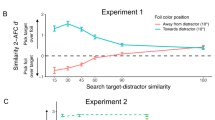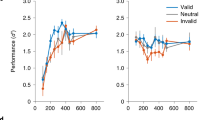Abstract
Visual attention allows an observer to select certain visual information for specialized processing. Selection is readily apparent in ‘tracking’ tasks where even with the eyes fixed, observers can track a target as it moves among identical distractor items1. In such a case, a target is distinguished by its spatial trajectory. Here we show that one can keep track of a stationary item solely on the basis of its changing appearance—specified by its trajectory along colour, orientation, and spatial frequency dimensions—even when a distractor shares the same spatial location. This ability to track through feature space bears directly on competing theories of attention, that is, on whether attention can select locations in space2,3,4, features such as colour or shape5,6,7, or particular visual objects composed of constellations of visual features. Our results affirm, consistent with a growing body of psychophysical8,9,10,11,12,13 and neurophysiological14,15,16 evidence, that attention can indeed select specific visual objects. Furthermore, feature-space tracking extends the definition of visual object17 to include not only items with well defined spatio-temporal trajectories18, but also those with well defined featuro-temporal trajectories.
This is a preview of subscription content, access via your institution
Access options
Subscribe to this journal
Receive 51 print issues and online access
$199.00 per year
only $3.90 per issue
Buy this article
- Purchase on Springer Link
- Instant access to full article PDF
Prices may be subject to local taxes which are calculated during checkout



Similar content being viewed by others
References
Pylyshyn, Z. W. & Storm, R. W. Tracking multiple independent targets: Evidence for a parallel tracking mechanism. Spatial Vision 3, 179–197 (1988).
Posner, M. I. Orienting of attention. Q. J. Exp. Psychol. 32, 3–25 (1980).
Sagi, D. & Julesz, B. Enhanced detection in the aperture of focal attention during simple discrimination tasks. Nature 321, 693–695 (1986).
Eriksen, C. W. & Hoffman, J. E. Temporal and spatial characteristics of selective encoding from visual displays. Percept. Psychophys. 12, 201–204 ( 1972).
Cavanagh, P. Attention-based motion perception. Science 257, 1563–1565 (1992).
Wolfe, J. M., Cave, K. R. & Franzel, S. L. Guided search: an alternative to the feature integration model for visual search. J. Exp. Psychol. Hum. Percept. Perform. 15, 419–433 ( 1989).
Corbetta, M., Miezin, F. M., Dobmeyer, S., Shulman, G. L. & Petersen, S. E. Attentional modulation of neural processing of shape, color, and velocity in humans. Science 248, 1556–1559 (1990).
Duncan, J. Selective attention and the organization of visual information. J. Exp. Psychol. Gen. 113, 501–517 (1984).
Valdes-Sosa, M., Cobo, A. & Pinilla, T. Transparent motion and object-based attention. Cognition 66, B13–B23 ( 1998).
Luck, S. J. & Vogel, E. K. The capacity of visual working memory for features and conjunctions. Nature 390, 279–281 (1997).
Kahneman, D., Treisman, A. & Gibbs, B. J. The reviewing of object files: object-specific integration of information. Cogn. Psychol. 24, 175– 219 (1992).
Baylis, G. C. & Driver, J. Visual attention and objects: evidence for hierarchical coding of location. J. Exp. Psychol. Hum. Percept. Perform. 19, 451–470 (1993).
Treisman, A. Feature binding, attention and object perception. Philos. Trans. R. Soc. Lond. B 353, 1295–1306 (1998).
Driver, J., Baylis, G. C. & Rafal, R. D. Preserved figure–ground segregation and symmetry perception in visual neglect. Nature 360, 73–75 (1992).
Valdes-Sosa, M., Bobes, M. A., Rodriguez, V. & Pinilla, T. Switching attention without shifting the spotlight object-based attentional modulation of brain potentials. J. Cogn. Neurosci. 10, 137–151 (1998).
O'Craven, K. M., Downing, P. E. & Kanwisher, N. fMRI evidence for objects as the units of attentional selection. Nature 401, 584– 587 (1999).
Treisman, A. & Paterson, R. Emergent features, attention, and object perception. J. Exp. Psychol. Hum. Percept. Perform. 10, 12–31 (1984).
von Hofsten, C. & Spelke, E. S. Object perception and object-directed reaching in infancy. J. Exp. Psychol. Gen. 114, 198–212 ( 1985).
Lappin, J. S. Attention in the identification of stimuli in complex visual displays. J. Exp. Psychol. 75, 321–328 (1967).
Bonnel, A. M. & Prinzmetal, W. Dividing attention between the color and the shape of objects. Percept. Psychophys. 60, 113–124 (1998).
He, S., Cavanagh, P. & Intriligator, J. Attentional resolution and the locus of visual awareness. Nature 383, 334–337 (1996).
Blaser, E., Sperling, G. & Lu, Z. L. Measuring the amplification of attention. Proc. Natl Acad. Sci. USA 96, 11681– 11686 (1999).
Qian, N., Andersen, R. A. & Adelson, E. H. Transparent motion perception as detection of unbalanced motion signals. I. Psychophysics. J. Neurosci. 14, 7357–7366 (1994).
Neisser, U. & Becklen, R. Selective looking: Attending to visually specified events. Cogn. Psychol. 7, 480–494 (1975).
Rock, I. & Gutman, D. The effect of inattention on form perception. J. Exp. Psychol. Hum. Percept. Perform. 7, 275–285 (1981).
Shih, S. I. & Sperling, G. Is there feature-based attentional selection in visual search? J. Exp. Psychol. Hum. Percept. Perform. 22, 758–779 ( 1996).
Sperling, G. & Melchner, M. J. The attention operating characteristic: examples from visual search. Science 202, 315–318 (1978).
Lee, D. K., Koch, C. & Braun, J. Attentional capacity is undifferentiated: concurrent discrimination of form, color, and motion. Percept. Psychophys. 61, 1241–1255 (1999).
Scholl, B. J. & Pylyshyn, Z. W. Tracking multiple items through occlusion: clues to visual objecthood. Cognit. Psychol. 38, 259–290 (1999).
Acknowledgements
This study was supported by an NIH Grant to Z.P. and an NRSA Institutional Postdoctoral Fellowship to E.B. We thank P. Cavanagh for helpful discussion and comments.
Author information
Authors and Affiliations
Corresponding author
Rights and permissions
About this article
Cite this article
Blaser, E., Pylyshyn, Z. & Holcombe, A. Tracking an object through feature space. Nature 408, 196–199 (2000). https://doi.org/10.1038/35041567
Received:
Accepted:
Issue Date:
DOI: https://doi.org/10.1038/35041567
This article is cited by
-
Mechanisms for individual, group-based and crowd-based attention to social information
Nature Reviews Psychology (2022)
-
Capturing the objects of vision with neural networks
Nature Human Behaviour (2021)
-
Common Structure of Vision and Olfaction
Philosophia (2021)
-
Structure of perceptual objects: introduction to the Synthese topical collection
Synthese (2021)
-
Competing rhythmic neural representations of orientations during concurrent attention to multiple orientation features
Nature Communications (2019)
Comments
By submitting a comment you agree to abide by our Terms and Community Guidelines. If you find something abusive or that does not comply with our terms or guidelines please flag it as inappropriate.



